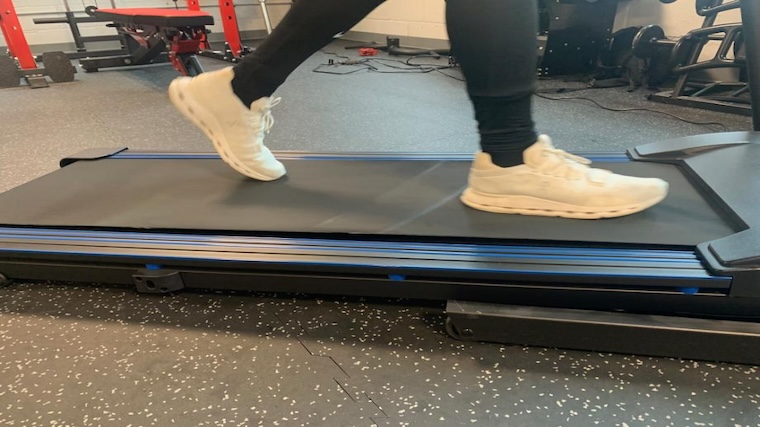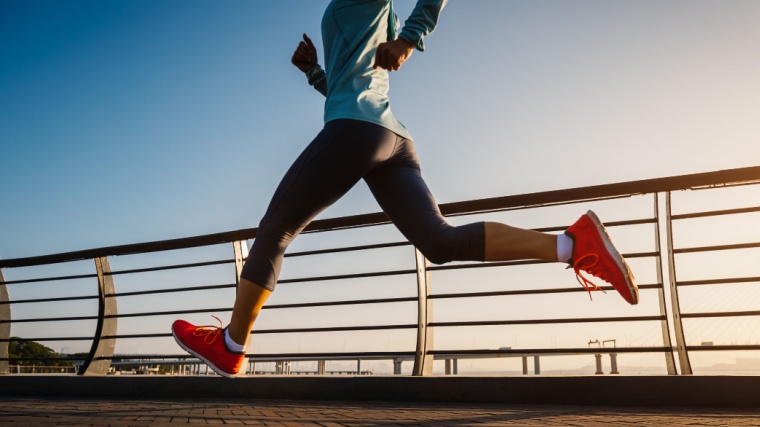If you’ve ever been to a running store, you probably found yourself paralyzed by all the options (we certainly were). Wall-to-wall displays of different types of running shoes; low-arch, high-arch, minimalist, extra cushioning … the list goes on and on.

And that’s without mentioning all the exams they can put you through, evaluating your foot shape, foot type, gait analysis, stride length, and much more. If you want to just grab a good pair of runners and hit the track or trail, you need to know what you’re looking for — how to choose the right running shoes for you. We’ve been there. Here’s what we’ve learned along the way.
What Are Running Shoes?
Bowling shoes are made for bowling; running shoes meet a runner’s sport-specific needs in the same way. The right running shoes for you will have adequate cushion, arch support, and fit snugly — but not tightly. However, there’s more that goes into the specific construction of running shoes that differentiate them from other types of athletic footwear.
Running Shoes vs. Cross-Training Shoes
Cross-training shoes can be worn on runs, but they won’t work as well as dedicated running footwear. That’s the main difference between running shoes vs. cross-trainers; the latter are made to perform decently well during cardio workouts, strength training, and everything in-between.
[Read More: Best Cross-Training Shoes of 2024 (Personally Tested)]
Put simply: You can do running workouts in cross-trainers, but they won’t work as well or be as comfortable as proper running footwear. Can you lift weights or perform a metcon in running shoes? Sure, but you’ll likely feel unstable and poorly supported.
Running Shoes vs. Walking Shoes
Active footwear are purpose-built. When you go on long walks — getting those steps in is a priority for us, too — not much matters more than comfort. Walking shoes are designed to maximize comfort and support since you can be on your feet for very long periods.

[Read More: The Best Shoes for Treadmill Running, Ran In and Tested by Our Experts]
Walking shoes typically have taller stack heights (the amount of material between your feet and the ground), which increases cushioning and gives them a “floatier” feel. Some walking shoes are designed to be extremely lightweight, but this isn’t a universal feature, and you can often find very light running shoes as well if you prefer.
How To Pick the Right Running Shoes
When it comes to choosing the right shoe, there are a number of different factors that you should bear in mind. Sure, getting a shoe that fits matters, but depending on how seriously you take your running game you may want to pay attention to these details as well:
Cushioning
Cushion refers to how much support the shoe provides to your foot, particularly your sole. Running shoes with lots of cushioning, also called maximalist runners, create a “floaty” feeling and dampen the sensation of ground contact, which some runners prefer.
However, there’s a drawback to too much cushioning as well. Some studies have shown that running in “highly-cushioned” shoes can make your legs stiff, which isn’t exactly ideal for vigorous cardio workouts. (1)
Heel Drop
Heel drop refers to the difference in stack height under the back of your foot versus the front. Most typical running shoes have around a 10-millimeter drop, but “minimalist” runners can have zero drop at all.
Shoes with more cushioning in the heel than the toe tend to encourage heel striking, which isn’t necessarily a bad thing. However, high-drop shoes and heel striking applies more force to your joints, which is something to consider when selecting your running shoes.
Arch Support & Pronation
Your feet are more complicated than you might think. There are a lot of small bones and connective tissue that affect how your foot contacts with and pushes off of the ground. And everyone has their own level of foot pronation, or “inward rolling”.
[Read More: How to Achieve Proper Running Form, Explained By Running Coaches]
Pronation isn’t inherently a bad thing and you can certainly be an accomplished runner if you have flat, pronated feet that require plenty of arch support. That said, this is one of the areas that you may want to consult a stride specialist. Most running shoe stores have resources available to help you understand your unique foot anatomy and gait cycle and can match you with a pair of shoes that service your unique needs.
Comfort, Fit, & Style
Sure, running shoes are a functional decision, and the track isn’t a fashion show. Still, we’re big proponents of the “look good, feel good, do good” mantra — it’s worth taking a few extra moments to shop around for a pair of runners that suit your fancy.

[Read More: How to Break in Running Shoes: A Running Coach Explains How To Do it Properly]
Beyond style, you’ll also want to make sure that your running shoes fit snugly without being painful or restrictive. Appropriately-fitted running shoes should not require a break-in period; they should hug your feet properly right out of the box and feel good when you start your next treadmill workout.
How Should Running Shoes Fit?
Few types of footwear fit perfectly out of the box. There’s a break-in period to leather boots, sure, but you shouldn’t have to suffer in your running shoes.
Shoe Length
There should be a small gap between the ends of your toes and the material in the forefoot of the shoe. Why? Well, as you run, your feet will naturally swell up slightly. If the shoes are grazing your toes when you’re idle, you may find them coarse or uncomfortable on long runs. This does not mean your shoes should be loose necessarily, but you shouldn’t be bunching your toes up in the shoe.
Shoe Width
The standard width measurement for men’s running shoes is “D”; for women, it’s “B”. Foot width varies more than you think, so you’ll want to make sure your shoes are appropriately wide.
Here’s a breakdown of common running shoe width measurements:
- Women’s 2A: Narrow
- Women’s B: Standard
- Women’s D: Wide
- Women’s 2E: Extra-wide
- Men’s B: Narrow
- Men’s D: Standard
- Men’s 2E: Wide
- Men’s 4E: Extra-wide
[Read More: How Long Do Running Shoes Last? Plus Tips From a Coach to Help Shoes Last Longer]
Heel Fit
When it comes to how your foot slips into the heel of the shoe, snugness should be a priority. Heel slipping — where the back of your foot slides up out of the shoe a little bit as you pick your foot up off the ground — can cause irritation and blisters, in addition to reducing your force output. Your heel should be snugly wrapped into the shoe and not move much when you run.
In-Step
A shoe’s in-step refers to how it accommodates feet with high arches. To identify whether you’ve got high arches, take a look at your footprint; if your footprint is narrow in the middle, you’ve got pronounced arches. If you see your “whole” foot, you likely have flat feet. Flat feet aren’t necessarily bad for running, but you should purchase a shoe that accommodates your in-step.
Frequently Asked Questions
How should you choose your running shoes?
You should choose running shoes based on function first and form second. The best way to identify the right pair is to head into a running specialty store and get fitted by a staff member there. Beyond that, look for running shoes that fit snugly but comfortably out of the box and don’t cause heel slipping or shin splints.
What are the types of running shoes?
There are a multitude of factors that go into running shoe selection. You’ll want to experiment with shoes that have varying levels of arch support and cushioning, as well as shoes with different levels of heel-to-toe drop.
What features are important in a running shoe?
Color! Just kidding — when you’re shopping for running shoes, prioritize inspecting features like heel drop, breathability and construction of the upper, lacing mechanism, and arch support.
References
- Kulmala, JP., Kosonen, J., Nurminen, J. et al. Running in highly cushioned shoes increases leg stiffness and amplifies impact loading. Sci Rep 8, 17496 (2018).
Featured Image: Ground Picture / Shutterstock